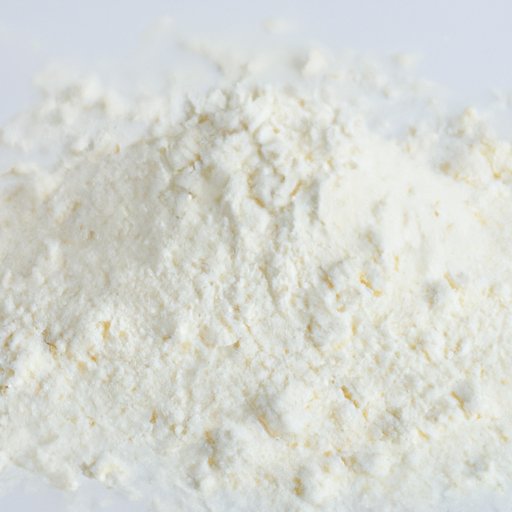
I. Introduction
Cornstarch is a commonly used thickening agent in various cooking and baking recipes. It is made from the starchy part of corn and is widely available in grocery stores. However, some people wonder if it is safe to consume cornstarch and whether it has any nutritional value. In this article, we will explore the nutritional benefits and potential health risks of consuming cornstarch, its uses in cooking and baking, and ways to incorporate it into your diet for better health.
II. Is Cornstarch Safe to Eat? A Look into Its Nutritional Value and Potential Health Risks
Cornstarch has little to no nutritional value as it mainly comprises carbohydrates and calories. About one tablespoon of cornstarch contains 30 calories, no protein, fiber, or fat, but has around 7 grams of carbohydrates. It is low in vitamins and minerals and almost does not provide any health benefits.
However, some people use cornstarch to thicken sauces, soups, and stews. It is also an ingredient in some desserts and baked goods. While using cornstarch can add thickness and texture to a dish, consuming it in large amounts may have potential health risks.
Cornstarch has a high glycemic index, meaning that it causes blood sugar levels to spike rapidly after ingestion. This can be a risk factor for people with diabetes or those who are at risk of developing the condition. Additionally, ingesting high amounts of cornstarch can result in abdominal pain, bloating, diarrhea, and gas.
III. Can You Use Cornstarch as a Flour Substitute in Baking?
Yes, cornstarch can be used as a substitute for flour in baking, especially when you aim to make baked goods lighter or flakier. As an alternative to wheat flour, a mixture of cornstarch and all-purpose flour can be a good solution. Cornstarch has less gluten and protein compared to regular flour, which means it will give your baked goods a tender texture and a finer crumb. However, making the substitution requires some adjustments in the recipe.
When using cornstarch as a flour substitute in baking, use a ratio of one tablespoon of cornstarch per two tablespoons of flour. When thickening pies or tarts, buttery mixes, or custards, cornstarch works better and provides a smoother texture. However, in recipes that require gluten formation, such as bread, it is better to stick with regular flour.
IV. How to Add Cornstarch to Your Diet for Better Health
While cornstarch has little nutritional value, incorporating it into your diet in small amounts can be beneficial. Cornstarch contains resistant starch, a type of carbohydrate that escapes digestion and ferments in the colon. This fermentation process produces short-chain fatty acids that promote gut health.
You can add cornstarch to your diet by using it as a thickener for sauces and soups or as a coating for fried foods. Additionally, you can use it to make low-calorie desserts such as pudding, custard, or mousse. Just be mindful of portion sizes and try to limit the intake of cornstarch to avoid potential health risks.
V. Cornstarch’s Versatility in Cooking and Baking
Cornstarch is commonly used as a thickening agent in cooking and baking. It can also be used to make gluten-free alternatives or as a coating for fried foods. Here are some recipes that use cornstarch in cooking or baking:
- Chicken Lo Mein
- Crispy Fried Chicken
- Creamy Mushroom Soup
- Chocolate Pudding
- Strawberry Shortcake
To achieve the desired effect when cooking with cornstarch, it is essential to mix it with a cold liquid before adding it to hot liquids. Mix cornstarch with water, milk, or any cold liquid before adding it to your dish. This will help prevent lumps from forming.
When storing cornstarch, place it in an airtight container in a cool, dry place away from direct sunlight. Make sure to check the expiry date and discard any cornstarch that has gone bad.
VI. Cornstarch: What You Need to Know Before Consuming it
While cornstarch can be an excellent ingredient in cooking and baking, there are some things to consider before consuming it. Firstly, excessive consumption of cornstarch can increase the risk of obesity, diabetes, and heart disease due to its high glycemic index. It is best to consume cornstarch in moderation and opt for other sources of nutrients and fiber.
Additionally, cornstarch is not suitable for people with celiac disease or gluten intolerance as it contains no gluten. This makes it an appropriate alternative for gluten-free baking, but be mindful of cross-contamination with gluten-containing ingredients.
VII. Conclusion
Cornstarch is a commonly used thickening agent in cooking and baking. While it has little nutritional value, it can be used as a flour substitute or incorporated into your diet in small amounts. Just be mindful of the potential health risks of consuming cornstarch in large amounts, and always use it in moderation. Incorporate cornstarch into your cooking and baking recipes for added texture and to try new recipe trends.
Final Thoughts: For most people, cornstarch is safe to consume in moderation. It can be a useful ingredient in cooking and baking and has potential health benefits if consumed in small amounts. So, go ahead and try using cornstarch in your next recipe.




